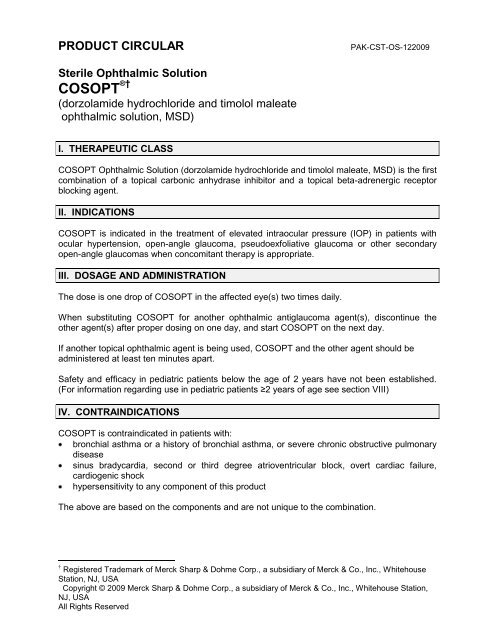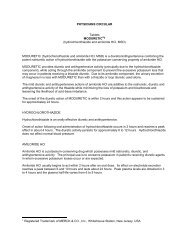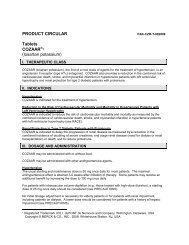COSOPT WPC DRAFT LABELING - OBS
COSOPT WPC DRAFT LABELING - OBS
COSOPT WPC DRAFT LABELING - OBS
Create successful ePaper yourself
Turn your PDF publications into a flip-book with our unique Google optimized e-Paper software.
PRODUCT CIRCULAR<br />
PAK-CST-OS-122009<br />
Sterile Ophthalmic Solution<br />
<strong>COSOPT</strong> ®†<br />
(dorzolamide hydrochloride and timolol maleate<br />
ophthalmic solution, MSD)<br />
I. THERAPEUTIC CLASS<br />
<strong>COSOPT</strong> Ophthalmic Solution (dorzolamide hydrochloride and timolol maleate, MSD) is the first<br />
combination of a topical carbonic anhydrase inhibitor and a topical beta-adrenergic receptor<br />
blocking agent.<br />
II. INDICATIONS<br />
<strong>COSOPT</strong> is indicated in the treatment of elevated intraocular pressure (IOP) in patients with<br />
ocular hypertension, open-angle glaucoma, pseudoexfoliative glaucoma or other secondary<br />
open-angle glaucomas when concomitant therapy is appropriate.<br />
III. DOSAGE AND ADMINISTRATION<br />
The dose is one drop of <strong>COSOPT</strong> in the affected eye(s) two times daily.<br />
When substituting <strong>COSOPT</strong> for another ophthalmic antiglaucoma agent(s), discontinue the<br />
other agent(s) after proper dosing on one day, and start <strong>COSOPT</strong> on the next day.<br />
If another topical ophthalmic agent is being used, <strong>COSOPT</strong> and the other agent should be<br />
administered at least ten minutes apart.<br />
Safety and efficacy in pediatric patients below the age of 2 years have not been established.<br />
(For information regarding use in pediatric patients ≥2 years of age see section VIII)<br />
IV. CONTRAINDICATIONS<br />
<strong>COSOPT</strong> is contraindicated in patients with:<br />
bronchial asthma or a history of bronchial asthma, or severe chronic obstructive pulmonary<br />
disease<br />
sinus bradycardia, second or third degree atrioventricular block, overt cardiac failure,<br />
cardiogenic shock<br />
hypersensitivity to any component of this product<br />
The above are based on the components and are not unique to the combination.<br />
† Registered Trademark of Merck Sharp & Dohme Corp., a subsidiary of Merck & Co., Inc., Whitehouse<br />
Station, NJ, USA<br />
Copyright © 2009 Merck Sharp & Dohme Corp., a subsidiary of Merck & Co., Inc., Whitehouse Station,<br />
NJ, USA<br />
All Rights Reserved
<strong>COSOPT</strong> ®<br />
(dorzolamide hydrochloride and timolol maleate ophthalmic solution, MSD)<br />
PAK-CST-OS-122009<br />
V. PRECAUTIONS<br />
Cardio-respiratory Reactions<br />
As with other topically-applied ophthalmic agents, this drug may be absorbed systemically. The<br />
timolol component is a beta-blocker. Therefore, the same types of adverse reactions found with<br />
systemic administration of beta-blockers may occur with topical administration.<br />
Because of the timolol maleate component, cardiac failure should be adequately controlled<br />
before beginning therapy with <strong>COSOPT</strong>. In patients with a history of severe cardiac disease,<br />
signs of cardiac failure should be watched for and pulse rates should be checked.<br />
Respiratory reactions and cardiac reactions, including death due to bronchospasm in patients<br />
with asthma and rarely death in association with cardiac failure, have been reported following<br />
administration of timolol maleate ophthalmic solution.<br />
Renal and Hepatic Impairment<br />
<strong>COSOPT</strong> has not been studied in patients with severe renal impairment<br />
(CrCl < 30 milliliter/min). Because dorzolamide hydrochloride and its metabolite are excreted<br />
predominantly by the kidney, <strong>COSOPT</strong> is not recommended in such patients.<br />
<strong>COSOPT</strong> has not been studied in patients with hepatic impairment and therefore should be<br />
used with caution in such patients.<br />
Immunology and Hypersensitivity<br />
As with other topically-applied ophthalmic agents, this drug may be absorbed systemically. The<br />
dorzolamide component is a sulfonamide. Therefore, the same types of adverse reactions<br />
found with systemic administration of sulfonamides may occur with topical administration, such<br />
as Stevens-Johnson syndrome and toxic epidermal necrolysis. If signs of serious reactions or<br />
hypersensitivity occur, discontinue use of this preparation.<br />
In clinical studies, local ocular adverse effects, primarily conjunctivitis and lid reactions, were<br />
reported with chronic administration of dorzolamide hydrochloride ophthalmic solution. Some of<br />
these reactions had the clinical appearance and course of an allergic-type reaction that<br />
resolved upon discontinuation of drug therapy. Similar reactions have been reported with<br />
<strong>COSOPT</strong>. If such reactions are observed, discontinuation of treatment with <strong>COSOPT</strong> should be<br />
considered.<br />
While taking -blockers, patients with a history of atopy or a history of severe anaphylactic<br />
reaction to a variety of allergens may be more reactive to accidental, diagnostic, or therapeutic<br />
repeated challenge with such allergens. Such patients may be unresponsive to the usual doses<br />
of epinephrine used to treat anaphylactic reactions.<br />
Concomitant Therapy<br />
There is a potential for an additive effect on the known systemic effects of carbonic anhydrase<br />
inhibition in patients receiving oral and topical carbonic anhydrase inhibitors concomitantly. The
<strong>COSOPT</strong> ®<br />
(dorzolamide hydrochloride and timolol maleate ophthalmic solution, MSD)<br />
PAK-CST-OS-122009<br />
concomitant administration of <strong>COSOPT</strong> and oral carbonic anhydrase inhibitors has not been<br />
studied and is not recommended.<br />
Patients who are already receiving a beta-adrenergic blocking agent systemically and who are<br />
given <strong>COSOPT</strong> should be observed for a potential additive effect either on the intraocular<br />
pressure or on the known systemic effects of beta-blockade. The use of two topical betaadrenergic<br />
blocking agents is not recommended.<br />
Other<br />
The management of patients with acute angle-closure glaucoma requires therapeutic<br />
interventions in addition to ocular hypotensive agents. <strong>COSOPT</strong> has not been studied in<br />
patients with acute angle-closure glaucoma.<br />
Choroidal detachment has been reported with administration of aqueous suppressant therapy<br />
(e.g., timolol, acetazolamide, dorzolamide) after filtration procedures.<br />
There is an increased potential for developing corneal edema in patients with low endothelial<br />
cell counts. Precautions should be used when prescribing <strong>COSOPT</strong> to this group of patients.<br />
Contact Lens Use<br />
<strong>COSOPT</strong> contains the preservative benzalkonium chloride, which may be deposited in soft<br />
contact lenses; therefore, <strong>COSOPT</strong> should not be administered while wearing these lenses.<br />
The lenses should be removed before application of the drops and not be reinserted earlier<br />
than 15 minutes after use.<br />
VI. PREGNANCY<br />
There are no adequate and well-controlled studies in pregnant women. <strong>COSOPT</strong> should be<br />
used during pregnancy only if the potential benefit justifies the potential risk to the fetus.<br />
VII. NURSING MOTHERS<br />
It is not known whether dorzolamide hydrochloride is excreted in human milk. Timolol maleate<br />
does appear in human milk. Because of the potential for serious adverse reactions on the<br />
nursing infant, a decision should be made whether to discontinue nursing or discontinue the<br />
drug, taking into account the importance of the drug to the mother.<br />
VIII. PEDIATRIC USE<br />
Safety and effectiveness in children have not been established.The safety and efficacy<br />
of 2% dorzolamide hydrochloride ophthalmic solution has been established in a clinical<br />
study of children under the age of 6 years. In this study patients under 6 and greater<br />
than 2 years of age whose IOP was not controlled with monotherapy received <strong>COSOPT</strong>.<br />
In those patients <strong>COSOPT</strong> was generally well tolerated.<br />
IX. DRUG INTERACTIONS<br />
Specific drug interaction studies have not been performed with <strong>COSOPT</strong>.<br />
In clinical studies, <strong>COSOPT</strong> was used concomitantly with the following systemic medications<br />
without evidence of adverse interactions: ACE-inhibitors, calcium channel blockers, diuretics,
<strong>COSOPT</strong> ®<br />
(dorzolamide hydrochloride and timolol maleate ophthalmic solution, MSD)<br />
PAK-CST-OS-122009<br />
non-steroidal anti-inflammatory drugs including aspirin, and hormones (e.g., estrogen, insulin,<br />
thyroxine).<br />
However, the potential exists for additive effects and production of hypotension and/or marked<br />
bradycardia when timolol maleate ophthalmic solution is administered together with oral calcium<br />
channel blockers, catecholamine-depleting drugs or beta-adrenergic blocking agents.<br />
Potentiated systemic beta-blockade (e.g., decreased heart rate, depression) has been reported<br />
during combined treatment with CYP2D6 inhibitors (e.g. quinidine, SSRIs) and timolol.<br />
The dorzolamide component of <strong>COSOPT</strong> is a carbonic anhydrase inhibitor and although<br />
administered topically, is absorbed systemically. In clinical studies, dorzolamide hydrochloride<br />
ophthalmic solution was not associated with acid-base disturbances. However, these<br />
disturbances have been reported with oral carbonic anhydrase inhibitors and have in some<br />
instances, resulted in drug interactions (e.g., toxicity associated with high-dose salicylate<br />
therapy). Therefore, the potential for such drug interactions should be considered in patients<br />
receiving <strong>COSOPT</strong>.<br />
Oral -adrenergic blocking agents may exacerbate the rebound hypertension which can follow<br />
the withdrawal of clonidine<br />
X. SIDE EFFECTS<br />
In clinical studies, <strong>COSOPT</strong> was generally well tolerated; no adverse experiences peculiar to<br />
this combination drug have been observed. Adverse experiences have been limited to those<br />
that were reported previously with dorzolamide hydrochloride and/or timolol maleate. In general,<br />
common adverse experiences were mild and did not cause discontinuation.<br />
During clinical studies, 1035 patients were treated with <strong>COSOPT</strong>. Approximately 2.4% of all<br />
patients discontinued therapy with <strong>COSOPT</strong> because of local ocular adverse reactions.<br />
Approximately 1.2% of all patients discontinued because of local adverse reactions suggestive<br />
of allergy or hypersensitivity. The most frequently reported drug-related adverse effects were:<br />
ocular burning and stinging, taste perversion, corneal erosion, conjunctival injection, blurred<br />
vision, tearing, and ocular itching. Urolithiasis was reported rarely.<br />
The following adverse reactions have been reported in post-marketing experience: dyspnea,<br />
respiratory failure, contact dermatitis, bradycardia, heart block, choroidal detachment following<br />
filtration surgery, nausea, Stevens-Johnson syndrome, and toxic epidermal necrolysis.<br />
XI. OVERDOSAGE<br />
No data are available with regard to human overdosage by accidental or deliberate ingestion of<br />
<strong>COSOPT</strong>.<br />
There have been reports of inadvertent overdosage with timolol maleate ophthalmic solution<br />
resulting in systemic effects similar to those seen with systemic beta-adrenergic blocking<br />
agents such as dizziness, headache, shortness of breath, bradycardia, bronchospasm, and<br />
cardiac arrest. The most common signs and symptoms to be expected with overdosage of<br />
dorzolamide are electrolyte imbalance, development of an acidotic state, and possibly central<br />
nervous system effects.
<strong>COSOPT</strong> ®<br />
(dorzolamide hydrochloride and timolol maleate ophthalmic solution, MSD)<br />
PAK-CST-OS-122009<br />
Treatment should be symptomatic and supportive. Serum electrolyte levels (particularly<br />
potassium) and blood pH levels should be monitored. Studies have shown that timolol does not<br />
dialyze readily.<br />
XII. AVAILABILITY<br />
Cosopt ® 2%, 0.5% (dorzolamide hydrochloride and timolol maleate opthalmic solution, MSD) is<br />
available in 5ml dispenser.<br />
<strong>COSOPT</strong> is a clear, colorless to nearly colorless, slightly viscous solution.<br />
XIIa. Storage<br />
<strong>COSOPT</strong> Ophthalmic Solution:<br />
Store at 15–30 C (59–86 F). Protect from light.




